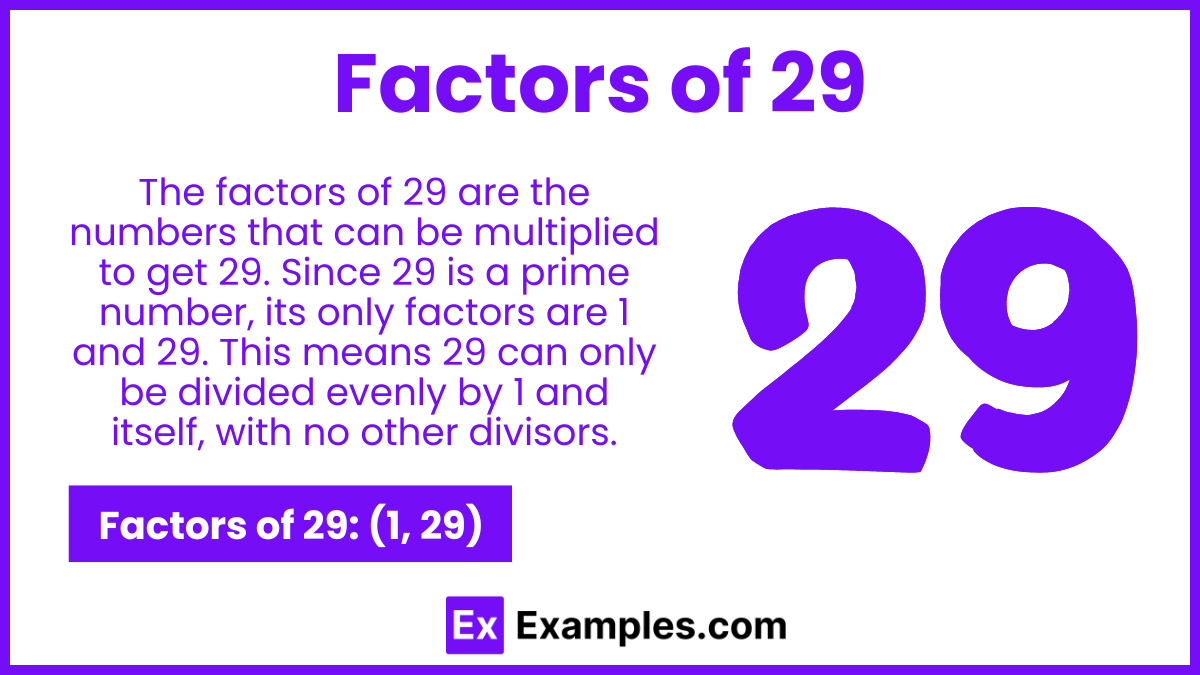Which of the following is a factor of 29?
1
2
3
4

The number 29 is a prime number, meaning it has only two factors: 1 and 29 itself. Understanding the factors of 29 is straightforward because, unlike composite numbers, prime numbers have no other divisors. This simplicity makes prime numbers like 29 significant in various mathematical applications, including prime factorization, cryptography, and number theory. Recognizing that 29 cannot be divided by any other number without leaving a remainder helps in simplifying equations and solving mathematical problems. In practical terms, knowing the factors of 29 can assist in identifying it as a prime number in larger sets of data and utilizing it in contexts where prime numbers play a crucial role, such as coding and encryption.

The factors of 29 are the numbers that can divide 29 without leaving a remainder. Since 29 is a prime number, it has only two factors: 1 and 29 itself. This means that 29 can only be divided evenly by 1 and 29. Understanding the factors of prime numbers like 29 is essential in various mathematical applications, including prime factorization, simplifying equations, and recognizing prime numbers in larger data sets.
Factor pairs are numbers that, when multiplied together, equal the original number. For 29, the only multiplication combination that works is 1 times 29, confirming its status as a prime number.
Prime factors are the prime numbers that multiply together to equal the original number. Since 29 is a prime number, it only has itself and 1 as its factors. Here’s how you can confirm that 29 is prime and determine its prime factors:
Problem: Identify the factors of 29.
Solution:
Problem: Verify that 29 is not divisible by any number other than 1 and itself.
Solution:
Problem: Confirm that 1 and 29 are the only pairs that multiply to 29.
Solution:
Problem: List all factor pairs of 29.
Solution:
Problem: Perform the prime factorization of 29.
Solution:
Understanding the factors of a number, especially prime numbers like 29, can be straightforward yet important for various mathematical tasks. Here are some tips to help you better understand and work with the factors of 29.
The prime factorization of 29 is simply 29, as it is a prime number and cannot be factored further into other prime numbers.
No, 29 cannot be divided evenly by any number other than 1 and itself, which is why it is classified as a prime number.
Yes, 29 can be a factor of any number that is a multiple of 29. For example, 58, 87, and 116 have 29 as a factor.
The GCF of 29 and any other number will depend on the second number. If the second number is not a multiple of 29, the GCF is 1. If it is a multiple of 29, the GCF is 29.
The positive pair factors of 29 are (1, 29) and (29, 1). The negative pair factors are (-1, -29) and (-29, -1).
The sum of all the factors of 29, which are 1 and 29, is 1+29=301+29=30.
Text prompt
Add Tone
10 Examples of Public speaking
20 Examples of Gas lighting
Which of the following is a factor of 29?
1
2
3
4
Which of these statements is true about the factors of 29?
29 has more than two factors
29 has exactly two factors
29 has no factors
29 has factors that are all even numbers
If you are listing all factors of 29, which number should not be included?
1
29
2
32
Which number below is not a factor of 29?
29
1
32
3
The number 29 is divisible by which of the following?
1 only
2 only
1 and itself
1, 2, and 29
Which of these numbers can be used to check if a number is a factor of 29?
29
30
31
32
When listing the factors of 29, which is the smallest number?
29
15
7
1
Which number is both a factor of 29 and less than 10?
5
2
1
7
Which number is not a factor of 29, based on the options given?
29
2
1
29
Which of the following is true about the number 29 in terms of factors?
It has multiple factors
It is a composite number
It has only two factors
It has no factors
Before you leave, take our quick quiz to enhance your learning!

